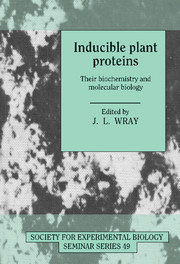Book contents
- Frontmatter
- Contents
- List of Contributors
- Preface
- Metal-binding proteins and metal-regulated gene expression in higher plants
- Phosphate starvation inducible enzymes and proteins in higher plants
- Nitrate reduction in higher plants: molecular approaches to function and regulation
- Inducibility of the glutamine synthetase gene family in Phaseolus vulgaris L.
- Expression and manipulation of genes involved in phenylpropanoid biosynthesis
- Biochemistry and molecular biology of CAM
- ABA- and GA-responsive gene expression
- Regulation of gene expression, ethylene synthesis and ripening in transgenic tomatoes
- Induction of nodulin genes and root nodule symbiosis
- Systemic acquired resistance: an inducible defence mechanism in plants
- Biochemistry and molecular biology of the anaerobic response
- The heat shock response in transgenic plants: the use of chimaeric heat shock genes
- Biochemistry and molecular biology of cold-inducible enzymes and proteins in higher plants
- GBF-1, GBF-2 and GBF-3: three Arabidopsis b-Zip proteins that interact with the light-regulated rbcS-1A promoter
- Index
Expression and manipulation of genes involved in phenylpropanoid biosynthesis
Published online by Cambridge University Press: 06 July 2010
- Frontmatter
- Contents
- List of Contributors
- Preface
- Metal-binding proteins and metal-regulated gene expression in higher plants
- Phosphate starvation inducible enzymes and proteins in higher plants
- Nitrate reduction in higher plants: molecular approaches to function and regulation
- Inducibility of the glutamine synthetase gene family in Phaseolus vulgaris L.
- Expression and manipulation of genes involved in phenylpropanoid biosynthesis
- Biochemistry and molecular biology of CAM
- ABA- and GA-responsive gene expression
- Regulation of gene expression, ethylene synthesis and ripening in transgenic tomatoes
- Induction of nodulin genes and root nodule symbiosis
- Systemic acquired resistance: an inducible defence mechanism in plants
- Biochemistry and molecular biology of the anaerobic response
- The heat shock response in transgenic plants: the use of chimaeric heat shock genes
- Biochemistry and molecular biology of cold-inducible enzymes and proteins in higher plants
- GBF-1, GBF-2 and GBF-3: three Arabidopsis b-Zip proteins that interact with the light-regulated rbcS-1A promoter
- Index
Summary
Introduction
The phenylpropanoid pathway leads to the biosynthesis of a large number of phenolic compounds in plants. The importance of this diverse class of chemicals originating from phenylalanine has been recognised for some time, as it plays a key role in plant development and protection against environmental stress. The variety of chemical structures synthesised includes compounds like quinones involved in electron transport (French et al., 1976), flavonoid pigments responsible for flower coloration (Ebel & Hahlbrock, 1982) and protection against UV irradiation (Hahlbrock et al., 1982), and cinnamic acid esters and phytoalexins involved in disease resistance (Dixon et al., 1983). Phenolic metabolites like acetosyringone activate bacterial genes such as the Agrobacterium virulence genes or Rhizobium nodulation genes in the rhizosphere (Downie & Johnston, 1986; Stachel & Zambryski, 1986). Salicylic acid, which is involved in systemic induced resistance, is induced after wounding. Lastly, lignin, a major cell wall polymer found in close association with cellulose fibres and hemicellulose in the xylem, is a product of the phenylpropanoid pathway (Lewis & Yamamoto, 1990).
The biosynthesis of some of these compounds, for example those involved in flower pigment biosynthesis, is well understood. In addition, the structure and pattern of expression of genes encoding these enzymes has been studied extensively. The application of novel techniques which permit the modulation of gene expression has recently led to the manipulation of genes involved in flavonoid biosynthesis in Petunia.
- Type
- Chapter
- Information
- Inducible Plant ProteinsTheir Biochemistry and Molecular Biology, pp. 97 - 112Publisher: Cambridge University PressPrint publication year: 1992



